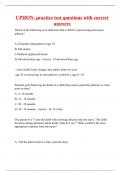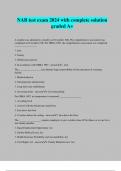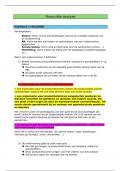3. CLASSIFICATION OF ELEMENTS AND
PERIODICITY IN PROPERTIES
Earlier classifications
1) Dobereiner’s classification:
Johann Dobereiner classified elements into small groups each containing three elements. These
small groups were called triads.
E.g. for triads are: i) 7Li 23Na 39K
ii) 40Ca 88Sr 137Ba
In triads, the atomic mass of the middle element is approximately the average of the other two
elements. This is known as Law of Triads. This classification was rejected, since the law of triad is
applicable only to a very few elements.
2) Newlands classification:
Newland arranged elements in the increasing order of their atomic masses. He noted that the
properties of every eighth element, starting from a given element, are similar to that of the first
element. The relationship is just like the resemblance of first and eighth musical notes. He named this as
law of octaves.
But his classification was rejected since the law of octaves was applicable to elements upto calcium.
A.E.B. de Chancourtois arranged elements in increasing order of atomic weights and made a
cylindrical table of elements to display the regular repetition of properties.
3) Lothar Meyer’s classification: Lothar Meyer plotted the physical properties of elements like
atomic volume, melting point and boiling point against atomic weight and obtained a periodically
repeated pattern. Based on this, he developed a periodic table similar to that of Mendeleev’s.
4) Mendeleev’s classification:
Dmitri Mendeleev (a Russian chemist) classified the elements in the increasing order of their atomic
weights. He found that the properties of elements repeat after a regular interval. Based on this
observation, he proposed a periodic law which states that “The properties of elements are the
periodic functions of their atomic weights.” That is, when elements are arranged in the increasing
order of their atomic weights, their properties repeat after a regular interval.
Mendeleev’s periodic table contains horizontal rows called series (periods) and vertical
columns called groups. Elements with similar properties are placed in the same group. He
mainly depends on the similarities in the empirical formulae and the properties of the
compounds formed by the elements. So he did not strictly obey the increasing order of
atomic weights. Also he corrected the wrong atomic masses of some elements.
When Mendeleev proposed his periodic table, some of the elements were not discovered. He
left some vacant places (gaps) for them in the periodic table and predicted some of their properties.
For e.g. both Gallium and Germanium were not discovered at that time. He named these elements as
Eka-Aluminium and Eka-Silicon respectively and predicted their properties. These elements were
discovered later and found that Mendeleev’s predictions were correct.
Merits of Mendeleev’s periodic table
1) It was the first comprehensive classification of elements.
2) He corrected the wrong atomic weights of some elements and placed them in correct
position in the periodic table.
3) He left vacant places for undiscovered elements and predicted some of their properties.
4) Elements with similar properties are placed in the same group.
+1 Chemistry Notes for 2023-24 : Prepared by ANIL KUMAR K L, APHSS ADICHANALLOOR Page 25
, Join Now: https://join.hsslive.in Downloaded from https://www.hsslive.in ®
Demerits of Mendeleev’s periodic table
1) Elements with dissimilar properties are found in same group.
2) He could not give an exact position for hydrogen.
3) He could not give exact position for Lanthanoids and Actinoids and also for isotopes.
4) Mendeleev’s periodic table did not strictly obey the increasing order of atomic weights.
Modern Periodic table
Henry Moseley’s work on the X-ray spectra of elements proved that atomic number is a more
fundamental property than atomic mass. Based on this observation, he modified the Mendeleev’s
periodic law as “the physical and chemical properties of elements are the periodic functions
of their atomic numbers”. This is known as Modern Periodic law.
Based on the modern periodic law, numerous forms of periodic tables have been proposed. The
most commonly used is the long form of periodic table.
In this periodic table, the elements are arranged in the increasing order of their atomic number.
It contains 7 horizontal rows called periods and 18 vertical columns called groups or families.
In the long form of modern periodic table, hydrogen has given a particular position at the top centre.
PERIODS
There are 7 periods in Modern periodic table. The period number corresponds to the highest
principal quantum number of the elements.
Period No. Elements No. of Elements Subshells filled Description
I 1H & 2He 2 1s Very short period
II 3 Li to 10Ne 8 2s & 2p
Short periods
III 11 Na to 18Ar 8 3s & 3p
IV 19K to 36Kr 18 4s, 3d & 4p
Long periods
V 37Rb to 54Xe 18 5s, 4d & 5p
VI 55Cs to 86Rn 32 6s, 4f, 5d & 6p
Longest periods
VII 87 Fr to 118 Og 32 7s, 5f, 6d & 7p
The 14 elements each of sixth and seventh periods are placed in separate rows below the main
body of the periodic table. These are together called inner transition elements. The 14 elements of
sixth period [from 57Ce (cerium) to 71Lu (lutetium)] are called Lanthanides or Lanthanones or
Lanthanoids or rare earths. The 14 elements of seventh period [from 90Th (thorium) to 103Lr
(lawrencium)] are called Actinides or Actinones or Actinoids.
GROUPS
Vertical columns in Long form of Modern periodic table are called groups or families. There are
18 groups and these are numbered from 1 to 18. Due to the similar outer electronic configuration and
same valency, the elements present in the same group have similar properties.
Group General outer Electronic
Elements Family name
No. configuration
1 Li, Na, K, Rb, Cs & Fr ns1 Alkali metals
2 Be, Mg, Ca, Sr , Ba & Ra ns2 Alkaline earth metals
3 to 12 4 rows of elements (n-1)d1 to 10 ns 0 to 2 Transition elements
13 B, Al, Ga, In, Tl & Nh 2
ns np 1 Boron Family
14 C, Si, Ge, Sn, Pb & Fl 2
ns np 2 Carbon Family
15 N, P, As, Sb, Bi & Mc 2
ns np 3 Nitrogen Family
16 O, S, Se, Te, Po & Lv ns2 np4 Oxygen Family
17 F, Cl, Br, I, At, Ts 2
ns np 5 Halogen Family
18 2
He, Ne, Ar, Kr, Xe, Rn, Og ns np 6 Noble gases
+1 Chemistry Notes for 2023-24 : Prepared by ANIL KUMAR K L, APHSS ADICHANALLOOR Page 26










